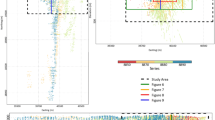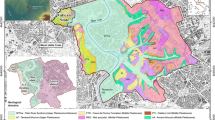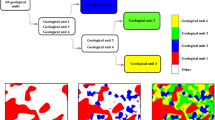Abstract
Obtaining accurate geological boundaries and assessing the uncertainty in these limits are critical for effective ore resource and reserve estimation. The uncertainty in the extent of an ore body can be the largest source of uncertainty in ore resource estimation when drilling is sparse. These limits are traditionally interpreted deterministically and it can be difficult to quantify uncertainty in the boundary and its impact on ore tonnage. The proposed methodology is to consider stochastic modeling of the ore boundary with a distance function recoding of the available data. This technique is modified to incorporate non-stationarities in the form of a locally varying anisotropy field used in kriging and sequential Gaussian simulation. Implementing locally varying anisotropy kriging retains the geologically realistic features of a deterministic model while allowing for a stochastic assessment of uncertainty. A case study of a gold deposit in Northern Canada is used to demonstrate the methodology. The proposed technique generates realistic, curvilinear geological boundary models and allows for an assessment of the uncertainty in the model.













Similar content being viewed by others
References
Aug C, Chilès J, Courrioux G, Lajaunie C (2004) 3D geological modeling and uncertainty: the potential field method. In: Leuangthong O, Deutsch C (eds) Seventh international geostatistics congress, Banff, Canada, pp 145–155
Banerjee S, Gelfand A (2006) Bayesian wombling. J Am Stat Assoc 101:1487–1501
Boisvert JB, Deutsch CV (2010) Programs for kriging and sequential Gaussian simulation with locally varying anisotropy using non-Euclidean distances. Comput Geosci 37:495–510
Boisvert JB, Deutsch CV (2011) Modeling locally varying anisotropy of CO2 emissions in the united states. Stoch Environ Res Risk Assess. doi:10.1007/s00477-011-0483-7
Calcagno P, Chilès J, Courrioux G, Guillen A (2008) Geological modelling from field data and geological knowledge. Part I. Modelling method coupling 3D potential-field interpolation and geological rules. Phys Earth Planet Inter 171:147–157
Carpenter RL, Sherlock RL, Quang C, Kleespies P, McLeod R (2003) Geology of the Doris north gold deposits, northern hope bay volcanic belt, slave structural province. Nunavut Geological Survey of Canada Current Research 2003-C6. 12 pp
Cherpeau N, Caumon G, Levy B (2010) Stochastic simulations of fault networks in 3D structural modeling. C R Geosci 342(9):687–694
Chilès J, Aug C, Guillen A, Lees T (2004) Modelling the geometry of geological units and its uncertainty in 3D from structural data: the potential-field method. In: Dimitrakopoulos R, Ramazan S (eds) Orebody modelling and strategic mine planning. Perth, WA, pp. 313–320
Cressie N (1993) Statistics for spatial data revised edn. Wiley, New York, p 900
Dijkstra E (1959) A note on two problems in connection with graphs. Numer Math 1(1):269–271
Fraser JA (1964) Geological notes on the northeastern district of MacKenzie Northwest territories. Geological Survey of Canada. 20 pp
Frondel C, Baum J (1974) Structure and mineralogy of the Franklin zinc-iron-manganese deposit. Econ Geol 69(2):157–180
Gabriel E, Allard D, Bacro J (2011) Estimating and testing zones of abrupt change for spatial data. Stat Comput 21:107–120
Gerbert J (1993) Geology and mineral potential of the Archean Hope Bay and Elu Inlet volcanic belts, northeastern Slave structural province, District of MacKenzie. Northern Affairs Program, Northwestern Territories Geology Division. 103 pp
Henrion V, Caumon G, Cherpeau N (2010) ODSIM: an object-distance simulation method for conditioning complex natural structures. Math Geosci 42(8):911–924
Holden L, Mostad P, Nielsen B, Gjerde J, Townsend C, Ottesen S (2003) Stochastic structural modeling. Math Geol 35(8):899–914
Isaaks E, Davis B (1999) The kriging oxymoron: conditionally unbiased and accurate prediction. In: SME annual meeting, Denver, CO
Isaaks E, Srivastava R (1989) An introduction to applied geostatistics. Oxford University Press, New York. 561 pp
Jones M, Baerentzen J, Sramek M (2006) 3D distance fields: a survey of techniques and applications. IEEE Trans Visual Computing Comput Graph 12(4):581–599
Journel A, Kyriakidis P (2004) Evaluation of mineral reserves: a simulation approach. Oxford University Press, New York. 232 pp
Krige D (1996) A practical analysis of the effects of spatial structure and data available and used. In: on conditional biases in ordinary kriging. In: 5th international geostatistics congress, Wollongong, Australia
Krige D, Assibey-Bonsu W (1999) Practical problems in the estimation of recoverable reserves when using kriging or simulation techniques. In: International symposium on geostatistical simulation in mining, Perth, Australia
Lajaunie C, Courrioux G, Manuel L (1997) Foliction fields and 3D cartography in geology: principles of a method based on potential interpolation. Math Geol 29:571–584
Lecour M, Cognot R, Duvinage I, Thore P, Dulac J (2001) Modelling of stochastic faults and fault networks in a structural uncertainty study. Pet Geosci 7:31–42
Lorensen W, Cline H (1987) Marching cubes: a high resolution 3D surface construction algorithm. Comput Graph 21:163–169
Mallet J (2002) Geomodeling. Oxford University Press, New York. 624 pp
Mallet J (2004) Space–time mathematical framework for sedimentary geology. Math Geol 36:1–32
McLennan J (2008) The decision of stationarity. PhD dissertation, University of Alberta, Canada. 191 pp
Sherlock RL, Carpenter RL, Bardoux M, Flkood E, Kleespies P (2002) Volcanic relationships and gold mineralization in the Wolverine–Madrid corridor, hope bay volcanic belt. Nunavut Geological Survey of Canada Current Research 2002-C9. 11 pp
Stroet C, Snepvangers J (2005) Mapping curvilinear structures with local anisotropy kriging. Math Geol 37:635–649
Womble W (1951) Differential systematics. Science 114:315–322
Xu W (1996) Conditional curvilinear stochastic simulation using pixel-based algorithms. Math Geol 28:937–949
Acknowledgements
The author would like to thank Newmont for providing the data set. Specifically, thanks are extended to Bruce Perry and Larry Allen for their assistance throughout the course of the work in both data preparation and helpful comments.
Author information
Authors and Affiliations
Corresponding author
Rights and permissions
About this article
Cite this article
Lillah, M., Boisvert, J.B. Stochastic Distance Based Geological Boundary Modeling with Curvilinear Features. Math Geosci 45, 651–665 (2013). https://doi.org/10.1007/s11004-012-9426-1
Received:
Accepted:
Published:
Issue Date:
DOI: https://doi.org/10.1007/s11004-012-9426-1




